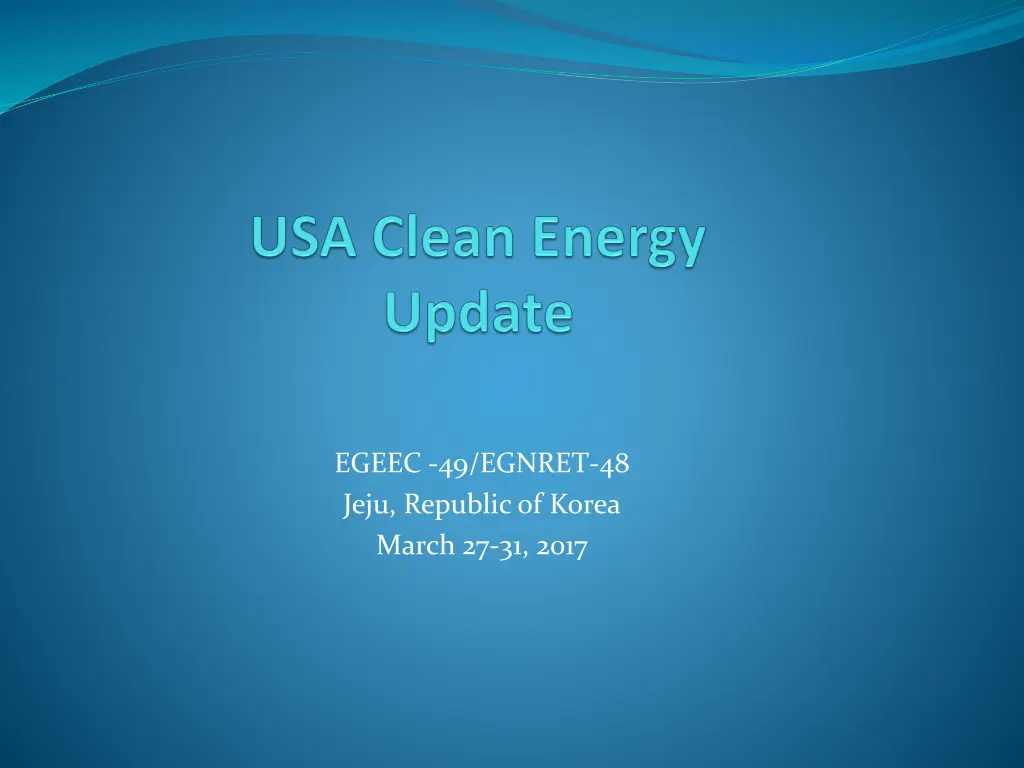
US Clean Energy Projects and Emissions Reduction Efforts 2016-2017
Discover the significant clean energy initiatives undertaken by the US from 2016-2017, including reductions in carbon dioxide emissions, federal energy efficiency contracts, wave energy testing facilities, biorefinery projects, and programs promoting solar access and zero energy districts.
Download Presentation

Please find below an Image/Link to download the presentation.
The content on the website is provided AS IS for your information and personal use only. It may not be sold, licensed, or shared on other websites without obtaining consent from the author. If you encounter any issues during the download, it is possible that the publisher has removed the file from their server.
You are allowed to download the files provided on this website for personal or commercial use, subject to the condition that they are used lawfully. All files are the property of their respective owners.
The content on the website is provided AS IS for your information and personal use only. It may not be sold, licensed, or shared on other websites without obtaining consent from the author.
E N D
Presentation Transcript
EGEEC -49/EGNRET-48 Jeju, Republic of Korea March 27-31, 2017
U.S. Energy related carbon dioxide emissions decline in most Annual Energy Outlook (AEO) cases, with the highest emissions projected in the No Clean Power Plan case January 5 2017: https://www.eia.gov/pressroom/presentations/sieminski_01052017.pdf 2
The U.S. has implemented a number of cross- cutting clean energy projects over 2016-2017 (1) Announcement that U.S. Federal Government facilities exceeded the President s Performance Contracting Goal by entering into energy efficiency and renewable energy performance contracts between 2011 and 2016 that are valued at $4.2 billion of investment and will save $8 billion over the next 18 years https://www.energy.gov/eere/articles/federal-government-exceeds- 4-billion-goal-renewable-energy-and-energy-efficiency Announcement of DOE funding for a new open-water, grid- connected national wave energy testing facility at Oregon State University to be completed by 2020 https://www.energy.gov/articles/energy-department-announces- investment-wave-energy-test-facility 3
The U.S. has implemented a number of cross- cutting clean energy projects over 2016-2017 (2) Announcement of DOE funding for the design-and-plan phase of 2 demonstration-scale integrated biorefineries, 2 pilot-scale integrated biorefineries, and 2 pilot-scale waste-to-energy projects https://www.energy.gov/eere/articles/energy-department- announces-six-projects-pilot-and-demonstration-scale- manufacturing Launch of the Solar in Your Community Challenge, a DOE program to expand solar access to populations who have been left out of the growing solar market; the Challenge encourages development of innovative financial and business models that serve low- and moderate-income communities, local governments, and non-profit organizations https://www.energy.gov/eere/articles/5-ways-cities-can-benefit- sunshot-s-latest-solar-prize-challenge 4
The U.S. has implemented a number of cross- cutting clean energy projects over 2016-2017 (3) Launch of the Better Buildings Zero Energy Districts Accelerator; with DOE support, six U.S. cities will develop plans and models for zero energy districts, which maximize energy efficiency and aggregate renewable energy sources within the district, so that the combined on- site renewable energy could offset the combined building energy consumption within the district https://www.energy.gov/eere/articles/energy-department-announces- partnerships-under-new-better-buildings-zero-energy Launch of the Reducing Embodied-energy and Decreasing Emissions (REMADE) Institute with DOE funding; it will focus on driving down the cost of technologies needed to reuse, recycle, and remanufacture materials, with the aim of achieving a 50-percent improvement in overall energy efficiency by 2027 https://www.energy.gov/articles/energy-department-launches-new- manufacturing-usa-institute-focused-recycling-and-reusing 5
Maryland increases renewable portfolio standard target to 25% by 2020 EIA: March 24, 2017: https://www.eia.gov/todayinenergy/detail.php?id=30492 This February, Maryland increased the renewables generation target in its renewable portfolio standard (RPS) to 25% of retail electricity sales by 2020, replacing the earlier target of 20% by 2022. The change occurred as legislators in both houses of the state s General Assembly voted to override the governor s veto of legislation they had first passed in 2016. 6
